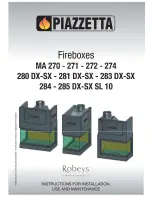
INTRODUCTION - THE POWER FLUE SYSTEM
INSTALLATION INSTRUCTIONS
POWER FLUE DESIGN
A ‘flue’ using a fan to remove or assist in removing combustion products from an appliance, is
known as a ‘power flue’.
POWER FLUE APPLICATION
A power flue application can be used to enable a client to have a decorative fire with a horizontal
flue run or a vertical flue run where flue space is inadequate for the normal flue.
VENTILATION REQUIREMENTS
Air supply to the unit is to be in accordance with ventilation Clause 5.4 of the Gas Code 601.
Ventilation requirements do not change by using a power flue. Refer page 19.
ACCESS TO POWER FLUE MOTOR
Access must be provided to the flue motor, this access MUST be at least 400mm x 400mm.
There MUST be a minimum clearance of 250mm between the top of the motor and any fixed
object i.e. ceiling or stud work. This is so the top of the fan box can be removed.
WIRING OF THE POWER FLUE
All wiring for the power flue is carried out at the factory and plug connectors are fitted for easy
installation. The power supply for the power flue is via a 3-pin plug at the rear of the firebox that
can be plugged into a power socket within the cavity.
ISOLATION SWITCH
If the power point is within a cavity an isolation switch accessible from outside the cavity must be
provided.
WIRING CLEARANCES
Wiring must at all times have a clearance of at least 150mm from the flue.
FAN FAILURE SENSING DEVICE
All Real Flame Power Flue systems are fitted with a sensing device within the unit to ensure that,
in the event of flow failure, the safety shut off valve within the module will go into lockout and shut
off the gas supply to the unit. The device should ALWAYS be in the vertical position. Refer to the
pressure differential switch on page 11.
‘LOCKOUT’
‘Lockout’ is the term used when the module in the unit senses a fault. When a fault is detected by
the module it will shut off the gas and go into lockout. If this occurs contact the manufacturer.
17
Summary of Contents for Hybrid 1000
Page 21: ...21 TYPICAL POWER FLUE FRAMEOUT Fan Casing Pressure Differential Switch Motor Motor...
Page 30: ...30...
Page 31: ...31...
















































